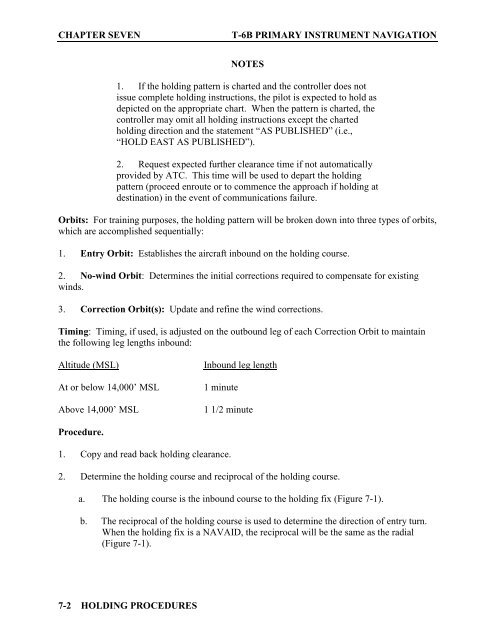Flight Training Instruction - Cnatra - U.S. Navy
Flight Training Instruction - Cnatra - U.S. Navy
Flight Training Instruction - Cnatra - U.S. Navy
Create successful ePaper yourself
Turn your PDF publications into a flip-book with our unique Google optimized e-Paper software.
CHAPTER SEVEN T-6B PRIMARY INSTRUMENT NAVIGATION<br />
7-2 HOLDING PROCEDURES<br />
NOTES<br />
1. If the holding pattern is charted and the controller does not<br />
issue complete holding instructions, the pilot is expected to hold as<br />
depicted on the appropriate chart. When the pattern is charted, the<br />
controller may omit all holding instructions except the charted<br />
holding direction and the statement “AS PUBLISHED” (i.e.,<br />
“HOLD EAST AS PUBLISHED”).<br />
2. Request expected further clearance time if not automatically<br />
provided by ATC. This time will be used to depart the holding<br />
pattern (proceed enroute or to commence the approach if holding at<br />
destination) in the event of communications failure.<br />
Orbits: For training purposes, the holding pattern will be broken down into three types of orbits,<br />
which are accomplished sequentially:<br />
1. Entry Orbit: Establishes the aircraft inbound on the holding course.<br />
2. No-wind Orbit: Determines the initial corrections required to compensate for existing<br />
winds.<br />
3. Correction Orbit(s): Update and refine the wind corrections.<br />
Timing: Timing, if used, is adjusted on the outbound leg of each Correction Orbit to maintain<br />
the following leg lengths inbound:<br />
Altitude (MSL) Inbound leg length<br />
At or below 14,000’ MSL 1 minute<br />
Above 14,000’ MSL 1 1/2 minute<br />
Procedure.<br />
1. Copy and read back holding clearance.<br />
2. Determine the holding course and reciprocal of the holding course.<br />
a. The holding course is the inbound course to the holding fix (Figure 7-1).<br />
b. The reciprocal of the holding course is used to determine the direction of entry turn.<br />
When the holding fix is a NAVAID, the reciprocal will be the same as the radial<br />
(Figure 7-1).
















